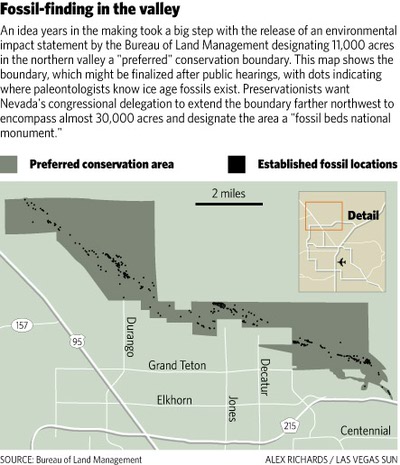Tuesday, Feb. 2, 2010 | 2 a.m.
Reader poll
Related Report
Sun Archives
- Tule Springs preservation prospects take off (8-16-2009)
- Tule Springs tours offer vistas into the past (5-11-2005)
- Valley residents get chance to protect Las Vegas Wash (4-29-2005)
- Researchers hoping to protect fossil sites (12-8-2004)
- More ancient treasures found (10-1-2003)
- Revisiting Tule Springs' 'Big Dig' (11-1-2002)
More information
- The BLM will publish printed notices of upcoming public hearings on the environmental impact statement at least two weeks before the hearings are held. Click here for more information.
Advocates for the preservation of a rich ice age fossil bed in the northern valley say a recently released federal study greatly aids their efforts to designate up to 30,000 acres as a national monument.
Last month the Bureau of Land Management released a draft environmental impact statement designating 11,000 acres — along the Upper Las Vegas Wash, just north of the Aliante master-planned community — as a “preferred” preservation site. Local activists see the 443-page document as supporting their goal of setting aside an even larger swath of land — up to 30,000 acres extending northwest along the wash — as a fossil bed national monument.
Jill DeStefano, leader of the Protectors of Tule Springs, which spearheaded the preservation movement, said the BLM’s “preferred” designation was unexpected and a huge boost to their endeavor.
“The BLM’s only mission was to look at 13,000 acres,” DeStefano said. “It didn’t have to come out with a preference.”
That it did, and for such a large amount of land, underscores the importance of the fossil record it contains. “If the area it studied is so important, it only magnifies the importance of the additional acres to the north, which are, by comparison, unspoiled and untouched,” she said.
National monument status would provide millions of dollars in federal support, along with oversight by the U.S. Park Service. Community leaders and local politicians think it would also create another tourist attraction and significant opportunities for scientific study by experts and local students.
The fossils have been known for at least 50 years. About 10,000 fossils from the area — most discovered in shallow digs during the laying of a transmission line several years ago — are stored at the San Bernardino County Museum in California.
But scientists say they have only scratched the surface.
When the BLM set out to the study the area almost 10 years ago, it focused on 13,000 acres. Since then, paleontologists have searched farther north along the Upper Las Vegas Wash and uncovered more fossils, many on or near the surface. During a walk-through of that area last summer, San Bernardino County scientists pointed out a number of exposed fossils, including a prehistoric camel bone sticking out of the dirt. They suspect thousands more fossilized remains of mammoths and other creatures that lived up to 100,000 years ago are buried there.
A map included with the BLM’s environmental impact statement shows more than 100 tiny circles, indicating the location of fossils within the 13,000-acre site. A corresponding satellite photo shows the fossils closely follow the Las Vegas Wash, which extends north beyond the area studied by the BLM.
Although much of the area is watched by the BLM and a permit is required to enter the area, preservationists want Congress to act soon to designate it a national monument to protect undiscovered fossils and rare plants such as the bear poppy from all-terrain vehicles, dirt bikes and explorers.
At this point, the effort to protect the area doesn’t appear to have opposition.
Lynn Davis, program manager of the Las Vegas field office of the National Parks Conservation Association, said initially there were doubts about the project because so many governmental entities touch its boundaries or have a stake in its future: Las Vegas, North Las Vegas, Clark County, Nellis Air Force Base and the Las Vegas Paiute Tribe.
Plans at one time were for a major highway to run through the site, bringing with it the requisite neighborhood casinos, car lots and strip malls. But the recession has stalled those plans.
Now political partners see the possibility of a national monument so close to the Strip as a welcome twist for the tourism economy. The Clark County Commission and Las Vegas and North Las Vegas city councils passed resolutions in November supporting federal park or monument status for the area.
“It’s rare to have the opportunity to create a national monument,” said Davis, whose organization’s mission is to preserve and increase the national park system. “But it’s even rarer for all the people to come together and work together.”
That message isn’t lost on Nevada’s congressional delegation.
Davis said Sen. John Ensign toured the area in January and has shown “great interest.” Senate Majority Leader Harry Reid’s office issued a statement last week noting he is in contact with stakeholders, and knows “there is strong interest locally in protecting the wash as a Fossil Beds National Monument.”
Ron Tipton, senior vice president of policy at the National Parks Conservation Association, said Reid, who is running for re-election, should act quickly if he wants to deliver a national monument before November. Congress is back in session and the legislative calendar is filling up.
“If Reid is going to introduce a bill with the Nevada delegation — and we think he will — it will need to be within the next few weeks,” Tipton said. “That is, if you want to see the bill before the elections.”


Join the Discussion:
Check this out for a full explanation of our conversion to the LiveFyre commenting system and instructions on how to sign up for an account.
Full comments policy